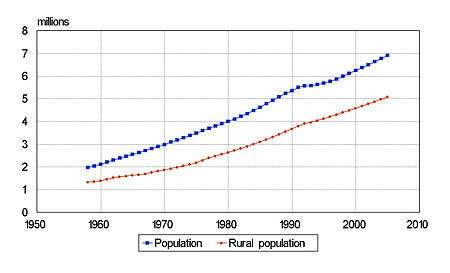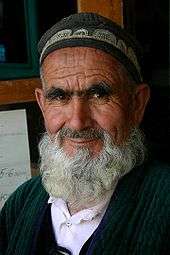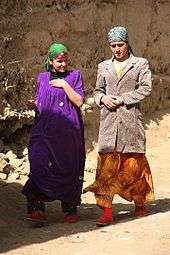Demographics of Tajikistan



The Demographics of Tajikistan is about the demographic features of the population of Tajikistan, including population growth, population density, ethnicity, education level, health, economic status, religious affiliations, and other aspects of the population.
Demographic trends
Tajikistan's main ethnic group are the Tajiks Persians, with minorities such as the Uzbeks and Kyrgyz, and a small Russian minority. Because not everyone in Tajikistan is an ethnic Tajik, the non-Tajik citizens of the country are referred to as Tajikistani. The official nationality of any person from Tajikistan is a Tajikistani, while the ethnic Tajik majority simply call themselves Tajik.
Contemporary Tajiks are an Iranian people and ethnic Persians. In particular, they are descended from ancient Eastern Iranian peoples of Central Asia, such as the Soghdians and the Bactrians, with an admixture of Western Iranian Persians as well as non-Iranian peoples.[1]
Until the 20th century, people in the region used two types of distinction to identify themselves: way of life - either nomadic or sedentary - and place of residence. By the late nineteenth century, the Tajik and Uzbek peoples, who had lived in proximity for centuries and often used each other's languages, did not perceive themselves as two distinct nationalities. The modern labels were imposed artificially when Central Asia was divided into five Soviet republics in the 1920s.[1]
Historically, Tajikistan and Uzbekistan were also home to Bukharan Jews, who trace their ancestry to the Lost Tribes of Israel taken captive by the Babylonians in the 7th century BC, but almost no Bukharian Jews are left in Tajikistan.[2]
Ethnic groups

Tajik Persian 89.9%, Uzbek 8.5%, Russian 1.1% (declining because of emigration), Kyrgyz 1.1%, other (including Pashtuns, Bukharian Jews and Volga Germans) 2.6% (2000 population census).
Ethnic makeup according to the population censuses from 1926 to 2000 (in thousands)[3][4][5]
Note: The category Tajiks also includes approximately 135,000 ethnic Pamiris, of which 65% are Shughni speakers, 13% are Rushani speakers, 12% speak Wakhi, 5% are Bartangi speakers, 3% are Yazgulyami speakers, 1.5% speak Khufi, and 0.8% are Ishkashimi speakers. In addition there are 5,000 speakers of Yagnobi. According to the 2000 census, excluding the people whose native languages are Pamiri or Yagnobi, Tajiks account for 77.6% of the population.
| Ethnic group |
census 19261 | census 19392 | census 19593 | census 19704 | census 19795 | census 19896 | census 2000 | census 20108 | ||||||||
|---|---|---|---|---|---|---|---|---|---|---|---|---|---|---|---|---|
| Number | % | Number | % | Number | % | Number | % | Number | % | Number | % | Number | % | |||
| Tajiks | 617,125 | 74.6 | 883,966 | 59.5 | 1,051,164 | 53.1 | 1,629,920 | 56.2 | 2,237,048 | 58.8 | 3,172,420 | 62.3 | 4,898,400 | 79.9 | 6,373,834 | 84.3 |
| Yagnobi | 1,829 | 0.2 | ||||||||||||||
| Uzbeks | 175,627 | 21.2 | 353,478 | 23.8 | 454,433 | 23.0 | 665,662 | 23.0 | 873,199 | 22.9 | 1,197,841 | 23.5 | 1,012,5007 | 16.5 | 1,046,6479 | 13.8 |
| Kyrgyz | 11,410 | 1.4 | 27,968 | 1.9 | 25,635 | 1.3 | 35,485 | 1.2 | 48,376 | 1.3 | 63,832 | 1.3 | 65,500 | 1.1 | 60,715 | 0.8 |
| Russians | 5,638 | 0.7 | 134,916 | 9.1 | 262,610 | 13.3 | 344,109 | 11.9 | 395,089 | 10.4 | 388,481 | 7.6 | 68,200 | 1.1 | 34,838 | 0.5 |
| Turkmen | 4,148 | 0.5 | 4,040 | 0.3 | 7,115 | 0.4 | 11,043 | 0.4 | 13,991 | 0.4 | 20,487 | 0.4 | 20,300 | 0.3 | 15,171 | 0.2 |
| Tatars | 950 | 0.1 | 18,296 | 1.2 | 56,893 | 2.9 | 70,803 | 2.4 | 79,529 | 2.1 | 79,442 | 1.6 | 19,000 | 0.3 | 6,495 | 0.1 |
| Arabs | 3,260 | 0.4 | 2,290 | 0.2 | 1,297 | 0.1 | 248 | 0.0 | 176 | 0.0 | 276 | 0.0 | 14,500 | 0.2 | 4,184 | 0.1 |
| Others | 7,180 | 0.9 | 60,137 | 4.0 | 120,750 | 6.1 | 142,332 | 4.9 | 158,812 | 4.2 | 169,824 | 3.3 | 29,100 | 0.5 | 22,618 | 0.3 |
| Total | 827,167 | 1,485,091 | 1,979,897 | 2,899,602 | 3,806,220 | 5,092,603 | 6,127,500 | 7,564,502 | ||||||||
| 1 Source: . 2 Source: . 3 Source: . 4 Source: . 5 Source: . 6 Source: 7 including 51,000 Lakai, 15,100 Kongrat, 4,900 Katagan, 3,700 Barlos and 1,100 Yuz. 8 Source: , p. 7. 9 including 65,555 Lakai, 38,078 Kongrat, 7,601 Katagan, 5,271 Barlos and 3,798 Yuz . | ||||||||||||||||
Languages
Several dialects of Tajik (a distinct dialect of the Persian), often mutually hard to understand by other speakers of Persian, are spoken in Tajikistan and it is its official language.[6] Russian is widely used in both government and business. The different ethnic minorities speak different languages, for instance Uzbek, Kyrgyz and Khowar.[7] In the Gorno-Badakhshan Autonomous Province, Shughni as well as other Pamir languages are spoken. In the northern Yaghnob valley, the Yaghnobi language is still spoken.
Religion

According to a 2009 U.S. State Department release, the population of Tajikistan is 90% Muslim, (approximately 85% Sunni and 5% Shia).[8] The remaining 10% of the population are followers of Russian Orthodoxy, or followers of other Christian churches (Roman Catholics, Seventh-day Adventists and Baptists). There also was a small Armenian minority, and a number of Zoroastrians. There are a small number of adherents to Bahá'í Faith and Judaism.
CIA World Factbook demographic statistics
- For the latest statistics, see this country's entry in the CIA World Factbook
The following demographic statistics are from the CIA World Factbook as of September 2009, unless otherwise indicated.
Population
7,349,145 (2009 est.)
8,610,000 (2015) [9]
Age structure
0–14 years: 34.3% (male 1,282,681/female 1,238,607)
15–64 years: 62.1% (male 2,260,552/female 2,303,034)
65 years and over: 3.6% (male 112,334/female 151,937) (2009 est.)
Population growth rate
1.88% (2009 est.) 2.21 % (2013-2014 est.) (source:www.stat.tj)
Net migration rate
-1.28 migrant(s)/1,000 population (2009 est.)
Sex ratio
at birth:
1.05 male(s)/female
under 15 years:
1.04 male(s)/female
15–64 years:
0.98 male(s)/female
65 years and over:
0.74 male(s)/female
total population:
0.99 male(s)/female (2009 est.)
Life expectancy at birth
total population:
65.33 years
male:
62.29 years
female:
68.52 years (2009 est.)
Education
Education is required through high school (12 years of schooling) but completion rate is under 90%;
Literacy
definition:
age 15 and over can read and write
total population:
99.5%
male:
99.7%
female:
99.2% (2000 census)
Vital statistics
UN estimates[10]
| Period | Live births per year | Deaths per year | Natural change per year | CBR1 | CDR1 | NC1 | TFR1 | IMR1 |
|---|---|---|---|---|---|---|---|---|
| 1950-1955 | 74 000 | 20 000 | 54 000 | 44.7 | 12.2 | 32.5 | 6.00 | 160.0 |
| 1955-1960 | 89 000 | 26 000 | 63 000 | 46.1 | 13.4 | 32.7 | 6.20 | 151.1 |
| 1960-1965 | 111 000 | 30 000 | 81 000 | 48.5 | 13.1 | 35.3 | 6.30 | 142.3 |
| 1965-1970 | 110 000 | 30 000 | 80 000 | 40.5 | 11.1 | 29.4 | 6.72 | 133.4 |
| 1970-1975 | 127 000 | 30 000 | 97 000 | 39.7 | 9.4 | 30.3 | 6.83 | 124.6 |
| 1975-1980 | 138 000 | 33 000 | 105 000 | 37.2 | 8.9 | 28.4 | 5.90 | 115.7 |
| 1980-1985 | 164 000 | 34 000 | 130 000 | 38.6 | 8.0 | 30.6 | 5.54 | 106.9 |
| 1985-1990 | 198 000 | 34 000 | 164 000 | 40.2 | 7.0 | 33.2 | 5.41 | 98.0 |
| 1990-1995 | 206 000 | 52 000 | 154 000 | 37.2 | 9.4 | 27.7 | 4.88 | 88.2 |
| 1995-2000 | 195 000 | 49 000 | 146 000 | 32.7 | 8.2 | 24.5 | 4.29 | 79.6 |
| 2000-2005 | 185 000 | 45 000 | 140 000 | 29.4 | 7.1 | 22.2 | 3.81 | 63.0 |
| 2005-2010 | 187 000 | 43 000 | 144 000 | 28.1 | 6.4 | 21.6 | 3.45 | 56.0 |
| 1 CBR = crude birth rate (per 1000); CDR = crude death rate (per 1000); NC = natural change (per 1000); TFR = total fertility rate (number of children per woman); IMR = infant mortality rate per 1000 births | ||||||||
Official statistics
Births and deaths[11][12]
| Average population (x 1000) | Live births in thousands | Deaths in thousands | Natural change | Crude birth rate (per 1000) | Crude death rate (per 1000) | Natural change (per 1000) | |
|---|---|---|---|---|---|---|---|
| 1950 | 1531,7 | 46,571 | 12,543 | 34,028 | 30.4 | 8.2 | 22.2 |
| 1951 | 1586,8 | 48,407 | 12,384 | 36,023 | 30.5 | 7.8 | 22.7 |
| 1952 | 1642,5 | 54,931 | 12,562 | 42,369 | 33.4 | 7.6 | 25.8 |
| 1953 | 1685,8 | 54,697 | 14,530 | 40,167 | 32.4 | 8.6 | 23.8 |
| 1954 | 1731,7 | 56,946 | 13,045 | 43,901 | 32.9 | 7.5 | 25.4 |
| 1955 | 1782,8 | 60,335 | 15,812 | 44,523 | 33.8 | 8.9 | 25.0 |
| 1956 | 1838,4 | 62,960 | 10,894 | 52,066 | 34.2 | 5.9 | 28.3 |
| 1957 | 1900,4 | 62,966 | 10,838 | 52,128 | 33.1 | 5.7 | 27.4 |
| 1958 | 1955,0 | 56,826 | 11,548 | 45,278 | 29.1 | 5.9 | 23.2 |
| 1959 | 2011,4 | 60,978 | 11,024 | 49,954 | 30.3 | 5.5 | 24.8 |
| 1960 | 2082,5 | 69,715 | 10,670 | 59,045 | 33.5 | 5.1 | 28.4 |
| 1961 | 2165,9 | 73,653 | 11,035 | 62,618 | 34.0 | 5.1 | 28.9 |
| 1962 | 2255,9 | 75,909 | 13,001 | 62,908 | 33.6 | 5.8 | 27.8 |
| 1963 | 2341,8 | 80,733 | 13,042 | 67,691 | 34.5 | 5.6 | 28.9 |
| 1964 | 2426,1 | 84,300 | 13,132 | 71,168 | 34.7 | 5.4 | 29.3 |
| 1965 | 2512,4 | 92,448 | 16,474 | 75,974 | 36.8 | 6.6 | 30.2 |
| 1966 | 2594,2 | 91,825 | 15,491 | 76,334 | 35.4 | 6.0 | 29.4 |
| 1967 | 2673,8 | 93,988 | 17,546 | 76,442 | 35.2 | 6.6 | 28.6 |
| 1968 | 2761,0 | 101,462 | 16,577 | 84,885 | 36.7 | 6.0 | 30.7 |
| 1969 | 2851,5 | 98,831 | 17,390 | 81,441 | 34.7 | 6.1 | 28.6 |
| 1970 | 2942,1 | 102,201 | 18,686 | 83,515 | 34.8 | 6.4 | 28.4 |
| 1971 | 3044,4 | 111,839 | 17,173 | 94,666 | 36.8 | 5.7 | 31.1 |
| 1972 | 3148,2 | 111,069 | 19,895 | 91,174 | 35.3 | 6.3 | 29.0 |
| 1973 | 3244,4 | 115,157 | 23,343 | 91,814 | 35.5 | 7.2 | 28.3 |
| 1974 | 3344,8 | 123,338 | 24,923 | 98,415 | 36.9 | 7.5 | 29.4 |
| 1975 | 3446,6 | 127,464 | 27,965 | 99,499 | 37.0 | 8.1 | 28.9 |
| 1976 | 3549,3 | 135,243 | 30,101 | 105,142 | 38.2 | 8.5 | 29.7 |
| 1977 | 3652,9 | 132,875 | 32,110 | 100,765 | 36.4 | 8.8 | 27.6 |
| 1978 | 3752,7 | 140,622 | 31,048 | 109,574 | 37.5 | 8.3 | 29.2 |
| 1979 | 3852,2 | 145,431 | 29,822 | 115,609 | 37.8 | 7.7 | 30.1 |
| 1980 | 3954,5 | 146,422 | 31,830 | 114,592 | 37.0 | 8.0 | 29.0 |
| 1981 | 4060,4 | 155,508 | 31,637 | 123,871 | 38.3 | 7.8 | 30.5 |
| 1982 | 4173,2 | 159,571 | 32,053 | 127,518 | 38.2 | 7.7 | 30.5 |
| 1983 | 4293,1 | 164,710 | 32,553 | 132,157 | 38.3 | 7.6 | 30.7 |
| 1984 | 4419,9 | 176,197 | 32,872 | 143,325 | 39.8 | 7.4 | 32.4 |
| 1985 | 4558,1 | 182,716 | 32,014 | 150,702 | 40.0 | 7.0 | 33.0 |
| 1986 | 4707,9 | 198,647 | 31,993 | 166,654 | 42.1 | 6.8 | 35.3 |
| 1987 | 4861,6 | 204,450 | 33,543 | 170,907 | 41.9 | 6.9 | 35.0 |
| 1988 | 5013,0 | 201,864 | 35,334 | 166,530 | 40.2 | 7.0 | 33.2 |
| 1989 | 5165,9 | 200,430 | 33,395 | 167,035 | 38.7 | 6.5 | 32.3 |
| 1990 | 5302,4 | 205,813 | 33,020 | 172,793 | 38.8 | 6.2 | 32.6 |
| 1991 | 5433,3 | 212,598 | 33,067 | 179,531 | 39.1 | 6.1 | 33.0 |
| 1992 | 5536,4 | 179,534 | 36,718 | 142,816 | 32.4 | 6.6 | 25.8 |
| 1993 | 5573,4 | 186,504 | 49,326 | 137,178 | 33.5 | 8.9 | 24.6 |
| 1994 | 5606,8 | 191,596 | 39,943 | 151,653 | 34.2 | 7.1 | 27.0 |
| 1995 | 5667,7 | 193,182 | 34,274 | 158,908 | 34.1 | 6.0 | 28.0 |
| 1996 | 5735,3 | 172,341 | 31,792 | 140,549 | 30.0 | 5.5 | 24.5 |
| 1997 | 5822,5 | 178,127 | 28,710 | 149,417 | 30.6 | 4.9 | 25.7 |
| 1998 | 5938,6 | 185,733 | 27,397 | 158,336 | 31.3 | 4.6 | 26.7 |
| 1999 | 6064,1 | 180,888 | 25,495 | 155,393 | 29.8 | 4.2 | 25.6 |
| 2000 | 6196,5 | 167,246 | 29,387 | 137,859 | 27.0 | 4.7 | 22.3 |
| 2001 | 6317,9 | 171,623 | 32,015 | 139,608 | 27.2 | 5.1 | 22.1 |
| 2002 | 6429,2 | 175,599 | 31,142 | 144,457 | 27.3 | 4.8 | 22.4 |
| 2003 | 6543,0 | 177,938 | 33,185 | 144,753 | 27.1 | 5.1 | 22.0 |
| 2004 | 6658,9 | 179,563 | 29,741 | 149,822 | 26.8 | 4.4 | 22.3 |
| 2005 | 6780,6 | 180,790 | 31,520 | 149,270 | 26.4 | 4.6 | 21.8 |
| 2006 | 6903,9 | 186,463 | 31,990 | 154,473 | 26.7 | 4.6 | 22.1 |
| 2007 | 7031,2 | 200,010 | 33,686 | 166,324 | 28.1 | 4.7 | 23.3 |
| 2008 | 7173,8 | 203,332 | 31,996 | 171,336 | 27.9 | 4.4 | 23.5 |
| 2009 | 7334,1 | 199,826 | 32,332 | 167,504 | 26.8 | 4.3 | 22.5 |
| 2010 | 7519,3 | 239,805 | 33,343 | 206,462 | 31.7 | 4.4 | 27.3 |
| 2011 | 7714,2 | 224,178 | 33,855 | 190,323 | 29.1 | 4.4 | 24.7 |
| 2012 | 7897,3 | 219,281 | 33,972 | 185,309 | 27.8 | 4.3 | 23.5 |
| 2013 | 8074,3 | 209,417 | 31,706 | 177,711 | 25.9 | 3.9 | 22.0 |
| 2014 | 8246.0 | 229,500 | 32,900 | 196,600 | 27.8 | 4.0 | 23.8 |
Fertility Rate (The Demographic Health Survey) [13]
Fertility Rate (TFR) (Wanted Fertility Rate) and CBR (Crude Birth Rate):
| Year | CBR (Total) | TFR (Total) | CBR (Urban) | TFR (Urban) | CBR (Rural) | TFR (Rural) |
|---|---|---|---|---|---|---|
| 2012 | 33,9 | 3,8 (3,3) | 28,9 | 3,3 (2,9) | 35,6 | 3,9 (3,4) |
See also
References
- 1 2 Library of Congress Country Studies - Tajikistan - Historical & Ethnic Background - 1996
- ↑ http://www.scpr.org/blogs/newmedia/2012/07/31/9242/alaev-family-bringing-jewish-music-bukhara-skirbal/
- ↑ Results of the 2000 population census in Tajikistan.
- ↑ Spoorenberg, Thomas (2013). "Fertility changes in Central Asia since 1980". Asian Population Studies 9 (1): 50–77. doi:10.1080/17441730.2012.752238.
- ↑ Spoorenberg, Thomas (2015). "Explaining recent fertility increase in Central Asia". Asian Population Studies (Routledge). doi:10.1080/17441730.2015.1027275.
- ↑ Constitution of the Republic of Tajikistan, November 6, 1994, Article 2.
- ↑ "Ethnologue report for Languages of Tajikistan". SIL International. Ethnologue: Languages of the World. Retrieved 5 May 2012.
- ↑ "Background Note: Tajikistan". State.gov. Retrieved 2009-10-02.
- ↑ De Wulf, Martin. "Population Pyramid". http://populationpyramid.net/tajikistan/2015/. External link in
|website=(help); - ↑ World Population Prospects: The 2010 Revision
- ↑ Official Tajikistan Government Statistic
- ↑ Естественное движение населения республик СССР, 1935 [Natural population growth of the Republics of the USSR, 1935] (in Russian). Demoscope.ru. Retrieved 31 March 2015.
- ↑ http://www.dhsprogram.com/
External links
| Wikimedia Commons has media related to Tajiks. |
- Ethnolinguistic map of Tajikistan by Iraj Bashiri
- Dr. Kurbanov, Ruslan. Majority Minoritized by Government: Muslims in Tajikistan. OnIslam.net. May 19, 2012.
| |||||||||||||||||||||||||||||||||||||||||||||||
| ||||||||||||||
